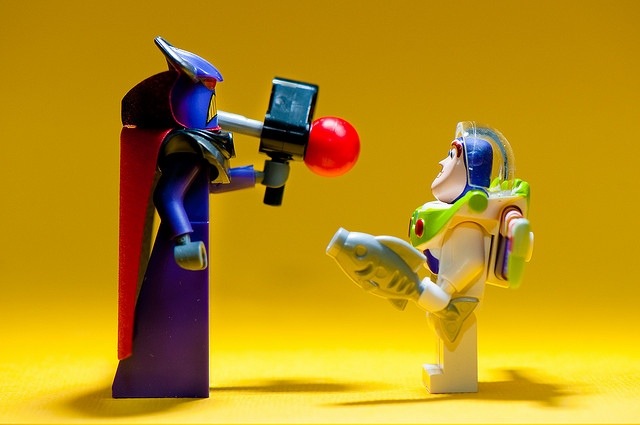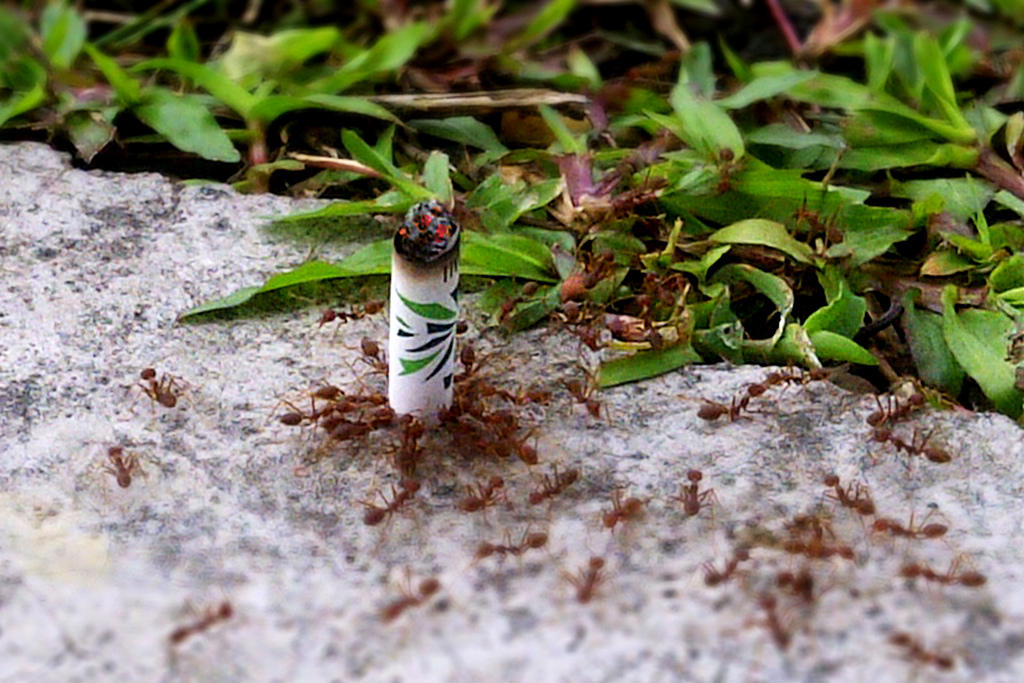Archive for the ‘Imagination’ Category
An Injection Of Absurdity
Things are cyclic, but there seems to be no end to the crusade of continuous improvement. (Does anyone remember how the Crusades turned out?) If only to take the edge off, there needs to be an injection of absurdity.
There’s no pressure with absurdity – no one expects an absurd idea to work. If you ask for an innovative idea, you’ll likely get no response because there’s pressure from the expectation the innovative idea must be successful. And if you do get a response, you’ll likely get served a plain burrito of incremental improvement garnished with sour cream and guacamole to trick your eye and doused in hot sauce to trick your palate. If you ask for an absurd idea, you get laughter and something you’ve never heard before.
When drowning in the sea of standard work, it takes powerful mojo to save your soul. And the absurdity jetpack is the only thing I know with enough go to launch yourself to the uncharted oasis of new thinking. Immense force is needed because continuous improvement has serious mass – black hole mass. Like with light, a new idea gets pulled over the event horizon into the darkness of incremental thinking. But absurdity doesn’t care. It’s so far from the center lean’s pull is no match.
But to understand absurdity’s superpower is to understand what makes things absurd. Things are declared absurd when they cut against the grain of our success. It’s too scary to look into the bright sun of our experiences, so instead of questioning their validity and applicability, the idea is deemed absurd. But what if the rules have changed and the fundamentals of last year’s success no longer apply? What if the absurd idea actually fits with the new normal? In a strange Copernican switch, holding onto to what worked becomes absurd.
Absurd ideas sometimes don’t pan out. But sometimes they do. When someone laughs at your idea, take note – you may be on to something. Consider the laughter an artifact of misunderstanding, and consider the misunderstanding a leading indicator of the opportunity to reset customer expectations. And if someone calls your idea absurd, give them a big hug of thanks, and get busy figuring out how to build a new business around it.
Decide To Tackle The Impossible
 Doing the impossible doesn’t take a long time, starting does. More precisely, what takes a long time is getting ready to start. Getting ready is the gating item. So what’s in the way?
Doing the impossible doesn’t take a long time, starting does. More precisely, what takes a long time is getting ready to start. Getting ready is the gating item. So what’s in the way?
The big deal about starting is other people will see you do it and they’ll judge you. Your brain tells stories about how people will think you’re silly or incompetent for trying the outrageous. It takes a long time to build the courage to start. But where starting is scary, getting ready is safe and comfortable. Getting ready is done in the head – it’s a private process. And because you do it in your head, you can do it without being judged, and you can do it for as long as you like. And you can take comfort in getting ready because you rationalize you’re advancing the ball with your thinking. (Hey, at least you’re thinking about it.) But the real reason for staying in the getting ready domain is starting the fear around being judged for starting.
After you finally mustered the courage to start, you’ll get welcomed with all sorts of well-intentioned, ill-informed criticism. The first one – We tried that before, and it didn’t work. Thing is, it was so long ago no one remembers what was actually tried. Also, no one remembers how many approaches were tried, and even fewer know why it didn’t work. But, everyone’s adamant it won’t work because it didn’t work. Your response – That was a long time ago, and things have changed since then. There are new technologies to try, new materials that may work, new experimental methods, and new analytical methods to inform the work.
Now that you dismissed the we-already-tried-that’s, the resource police will show up at your door. They’ll say – That’s a huge project and it will consume all our resources. You can’t do that. Your response – Well, I’m not eating the whole enchilada, I only taking the right first bite. And for that, I don’t need any extra resources. You see, my friends and I really want to do this and we pooled our resources and narrowly defined the first bite. So, as far as resources, I’m all set.
Now the alignment officers will find you. They’ll say – Your off-topic mission impossible will confuse and distract our organization and we can’t have that. You know there’s no place for passion and excitement around here. Can you imagine engineers running around doing things that could disrupt our decrepit business model? We’ll no longer have control, and we don’t like that. Please stop. Your response – Let’s set up a meeting with the CEO who’s on the hook to create new businesses, and you can deliver that message face-to-face. You want me to set up the meeting?
Lastly, the don’t-rock-the-boaters will nip at your heels. They’ll say – Things are going pretty well. Did you hear we’re laying off fewer people this quarter? And, we’re losing less money this quarter. Things are looking up. And here you are trying something new, and scaring everyone half to death. You’ve got to stop that nonsense. Your response – Though it may be scary, I have a hunch this crazy stuff could create a whole new business and help secure the company’s future. And I have kids going to college in a couple years, and the company’s future is important to me.
When doing the impossible, the technical part is the easy part. Once you decide to try, what you thought impossible comes quickly. What’s difficult is the people part. Doing the impossible is unpredictable, and it cuts across grain of our culture of predictability. For years it’s been well defined projects with guaranteed profits and completion dates etched in stone. And after years of predictability injections people become the antibodies that reject the very work the company needs – the work that delivers the impossible.
No kidding – once you start the impossible, your organization will make it difficult for you. But, that’s nothing compared to the difficulty of getting ready because in that phase, you must overcome the most powerful, sly, dangerous critic of all – yourself.
Weak Signals And The Radical Fringe
We strive to get everyone on the same page, to align the crew in a shared direction. The thinking goes – If we’re all pulling in the same direction, we’ll get there faster and more efficiently. Yes, the destination will come sooner, but what if it’s not there when we get there?
There’s implicit permanence to our go-forward travel plans. We look out three years and plan our destination as if today’s rules and fundamentals will still apply. We think – That imaginary tropical vacation spot will be beautiful in three years because it looks beautiful through the kalidascope of today’s success. But as the recent natural disasters have taught us, whole islands can be destroyed in an instant. But still, the impermenance of today’s tried-and-true business models is lost on us, and we see the unknowable future as statically as the unchangeable map of the continents.
Thing is, all around us there are weak indications the fundamental tradewinds have started to shift – weak signals of impermenance that may invalidate today’s course heading. But weak signals are difficult to hear – the white noise of yesterday’s success drowns out the forward-looking weak signals. And more problematic, once heard, weak signals are easily dismissed because their song threatens the successful status quo.
You feel weak signals in your chest. It could be a weak signal when your experience tells you things should go one way and they actually go another. Martin Zwilling (Forbes) has some great examples. (Thanks to Deb Mills-Scofield [@dscofield] for retweeting the article.)
100% alignment reduces adaptability because it deadens us to weak signals, and that’s a problem in these times of great impermanence. To counter the negative elements of alignment, there must be a balancing injection of healthy misalignment. This is an important and thankless task falls on the shoulders of a special breed – the radical fringe. They’re the folks smart enough to knit disjointed whispers into coherent ideas that could unravel everything and brave enough to test them.
Disruptive movements and revolutions build momentum quietly and slowly. But if you can recognize them early, there’s a chance you can get into position to ride their tsunami instead of being ambushed and scuttled by it. But you’ve got to listen closely because these young movements are stealthy and all they leave in their wake are weak signals.
Less Before More – Innovation’s Little Secret
 The natural mindset of innovation is more-centric. More throughput; more performance; more features and functions; more services; more sales regions and markets; more applications; more of what worked last time. With innovation, we naturally gravitate toward more.
The natural mindset of innovation is more-centric. More throughput; more performance; more features and functions; more services; more sales regions and markets; more applications; more of what worked last time. With innovation, we naturally gravitate toward more.
There are two flavors of more, one better than the other. The better brother is more that does something for the first time. For example, the addition of the first airbags to automobiles – clearly an addition (previous vehicles had none) and clearly a meaningful innovation. More people survived car crashes because of the new airbags. This something-from-nothing more is magic, innovative, and scarce.
Most more work is of a lesser class – the more-of-what-is class. Where the first airbags were amazing, moving from eight airbags to nine – not so much. When the first safety razors replaced straight razors, they virtually eliminated fatal and almost fatal injuries, which was a big deal; but when the third and fourth blades were added, it was more trivial than magical. It was more for more’s sake; it was more because we didn’t know what else to do.
While more is more natural, less is more powerful. The Innovator’s Dilemma clearly called out the power of less. When the long-in-the-tooth S-curve flattens, Christensen says to look down, to look down and create technologies that do less. Actually, he tells us someone will give ground on the very thing that built the venerable S-curve to make possible a done-for-the-first-time innovation. He goes on to say you might as well be the one to dismantle your S-curve before a somebody else beats you to it. Yes, a wonderful way to realize the juciest innovation is with a less-centric mindset.
The LED revolution was made possible with less-centric thinking. As the incandescent S-curve hit puberty, wattage climbed and more powerful lights became cost effective; and as it matured, output per unit cost increased. More on more. And looking down from the graying S-curve was the lowly LED, whose output was far, far less.
But what the LED gave up in output it gained in less power draw and smaller size. As it turned out, there was a need for light where there had been none – in highly mobile applications where less size and weight were prized. And in these new applications, there was just a wisp of available power, and incandesent’s power draw was too much. If only there was a technology with less power draw.
But at the start, volumes for LEDs were far less than incandesent’s; profit margin was less; and most importantly, their output was far less than any self-respecting lightbulb. From on high, LEDs weren’t real lights; they were toys that would never amount to anything.
You can break intellectual inertia around more, and good things will happen. New design space is created from thin air once you are forced from the familiar. But it takes force. Creative use of constraints can help.
Get a small team together and creatively construct constraints that outlaw the goodness that makes your product great. The incandescent group’s constraint could be: create a light source that must make far less light. The automotive group’s constraint: create a vehicle that must have less range – battery powered cars. The smartphone group: create a smartphone with the fewest functions – wrist phone without Blutooth to something in your pocket , longer battery life, phone in the ear, phone in your eyeglasses.
Less is unnatural, and less is scary. The fear is your customers will get less and they won’t like it. But don’t be afraid because you’re going to sell to altogether different customers in altogether markets and applications. And fear not, because to those new customers you’ll sell more, not less. You’ll sell them something that’s the first of its kind, something that does more of what hasn’t been done before. It may do only a little bit of that something, but that’s far more than not being able to do it all.
Don’t tell anyone, but the next level of more will come from less.
Choose Yourself
 We’ve been conditioned to ask for direction; to ask for a plan; and ask for permission. But those ways no longer apply. Today that old behavior puts you at the front of the peloton in the great race to the bottom.
We’ve been conditioned to ask for direction; to ask for a plan; and ask for permission. But those ways no longer apply. Today that old behavior puts you at the front of the peloton in the great race to the bottom.
The old ways are gone.
Today’s new ways: propose a direction (better yet, test one out on a small scale); create and present a radical plan of your own (or better, on the smallest of scales test the novel aspects and present your learning); and demonstrate you deserve permission by initiating activity on something that will obsolete the very thing responsible for your success.
People that wait for someone to give them direction are now a commodity, and with commodities it always ends in the death spiral of low cost providers putting each other out of business. As businesses are waist deep in proposals to double-down on what hasn’t worked and are choking on their flattened S-curves, there’s a huge opportunity for people that have the courage to try new things on their own. Today, if you initiate you’ll differentiate.
[This is where you say to yourself – I’ve already got too much on my plate, and I don’t have the time or budget to do more (and unsanctioned) work. And this is where I tell you your old job is already gone, and you might as well try something innovative. It’s time to grab the defibrillator and jolt your company out of its flatline. ]
It’s time to respect your gut and run a low cost, micro-experiment to test your laughable idea. (And because you’ll keep the cost low, no one will know when it doesn’t go as you thought. [They never do.]) It’s time for an underground meeting with your trusted band of dissidents to plan and run your pico-experiment that could turn your industry upside down. It’s time to channel your inner kindergartener and micro-test the impossible.
It’s time to choose yourself.
The One Thing To Believe In
I used to believe in control, now I believe in trust.
I used to believe in process, now I believe in judgment.
I used to believe in WHAT and HOW, now I believe in WHO and WHY.
I used to believe in organizational structure, now I believe in personal relationships.
I used to believe in best practices, now I believe in the judgment to choose the right practices.
I used to believe in shoring up weaknesses, now I believe in building on strengths.
I used to believe in closing the gap, now I believe in the preferential cowpath.
I used to believe in innovation, now I believe in inspiration.
I used to believe in corrective action, now I believe in passionate action.
I used to believe in top down, now I believe in the people that do the work.
I used to believe in going fast, now I believe in doing it right as the means to go fast.
I used to believe in the product development process, now I believe in the people executing it.
I used to believe the final destination, now I believe in the current location.
I used to believe in machines, now I believe in the people that run them.
I used to believe in technology, now I believe in the people developing it.
I used to believe in hierarchy, now I believe in personal responsibility.
But if there’s one thing to believe in, I believe in people.
The Invisible Rut of Success
It’s easier to spot when it’s a rut of failure – product costs too high, product function is too low, and the feeding frenzy where your competitors eat your profits for lunch. Easy, yes, but still possible to miss, especially when everyone’s super busy cranking out heaps of the same old stuff in the same old way, and demonstrating massive amounts of activity without making any real progress. It’s like treading water – lots of activity to keep your head above water, but without the realization you’re just churning in the same place.
But far more difficult to see (and far more dangerous) is the invisible rut of success, where cranking out the same old stuff in the same old way is lauded. Simply put – there’s no visible reason to change. More strongly put, when locked in this invisible rut newness is shunned and newness makers are ostracized. In short, there’s a huge disincentive to change and immense pressure to deepen the rut.
To see the invisible run requires the help of an outsider, an experienced field guide who can interpret the telltale signs of the rut and help you see it for what it is. For engineering, the rut looks like cranking out derivative products that reuse the tired recipes from the previous generations; it looks like using the same old materials in the same old ways; like running the same old analyses with the same old tools; all-the-while with increasing sales and praise for improved engineering productivity.
And once your trusted engineering outsider helps you see your rut for what it is, it’s time to figure out how to pull your engineering wagon out of the deep rut of success. And with your new plan in hand, it’s finally time to point your engineering wagon in a new direction. The good news – you’re no longer in a rut and can choose a new course heading; the bad news – you’re no longer in a rut so you must choose one.
It’s difficult to see your current success as the limiting factor to your future success, and once recognized it’s difficult to pull yourself out of your rut and set a new direction. One bit of advice – get help from a trusted outsider. And who can you trust? You can trust someone who has already pulled themselves out of their invisible rut of success.
Self-Perspective Using Mental Time Travel
 If you’re sitting in the present, you’re sitting in a good place – you’re more mindful of what’s going on, more aware of your thinking, and more thoughtful of your actions. But there’s one thing sitting in the present can’t provide, and that’s perspective. To create perspective, to understand the hows and whys of your journey to the present, requires reflection on the past. But to self reflect without distorting the image requires separation from your present.
If you’re sitting in the present, you’re sitting in a good place – you’re more mindful of what’s going on, more aware of your thinking, and more thoughtful of your actions. But there’s one thing sitting in the present can’t provide, and that’s perspective. To create perspective, to understand the hows and whys of your journey to the present, requires reflection on the past. But to self reflect without distorting the image requires separation from your present.
Here’s an idea to create separation – an exercise in mental time travel where your past becomes your present and your present becomes your future. It goes like this: Set your mental way-back machine for five years ago, turn the crank and jump back to a five-years-ago present. From your seat in your new present (your past), erase your future (your present) to open it up to unlimited possibilities. Now, imagine a future (one of the infinite possible futures) that is identical to the one that actually happened. (But remember, you don’t know it happened, so it’s only a potential future state.) Okay. You’re now ready to mint your own perspective.
From your seat in your new present (your past), ask yourself three questions.
If your imagined future (your actual present state) came to be:
- How would you feel about your relationships with your friends, your community, and your family?
- How would you feel about your health?
- How would you feel about the alignment between your actions, values, and passions?
With your answers in hand (and I suggest you actually write them down), use your way-back machine to jump forward to the present present. Sitting in the present (the real one), read your answers (written five years ago) to the three questions above.
How do you feel about your answers? What do you like about your answers? What makes you uncomfortable? What surprised you? Write down your answers because that’s the unfiltered perspective you were looking for.
Now the valuable part – two final questions (write down the actual answers):
Taking guidance from your newly self-minted perspective:
- Going forward, while sitting in the present, what will you do more of?
- Going forward, while sitting in the present, what will you do less of?
If you are sufficiently intrigued (or confused) to try the exercise and find value in it, please pay it forward and share it with others.
And don’t forget to repeat the process every year.
Innovation Eats Itself
 We all want more innovation, though sometimes we’re not sure why. Turns out, the why important.
We all want more innovation, though sometimes we’re not sure why. Turns out, the why important.
We want to be more innovative. That’s a good vision statement, but it’s not actionable. There are lots of ways to be innovative, and it’s vitally important to figure out the best flavor. Why do you want to be more innovative?
We want to be more innovative to grow sales. Okay, that’s a step closer, but not actionable. There are many ways to grow sales. For example, the best and fastest way to sell more units is to reduce the price by half. Is that what you want? Why do you want to grow sales?
We want to be more innovative to grow sales so we can grow profits. Closer than ever, but we’ve got to dig in and create a plan.
First, let’s begin with the end in mind. We’ve got to decide how we’ll judge success. How much do we want to grow profits? Double, you say? Good – that’s clear and measurable. I like it. When will we double profits? In four years, you say? Another good answer – clear and measureable. How much money can we spend to hit the goal? $5 million over four years. And does that incremental spending count against the profit target? Yes, year five must double this year’s profits plus $5 million.
Now that we know the what, let’s put together the how. Let’s start with geography. Will we focus on increasing profits in our existing first world markets? Will we build out our fledgling developing markets? Will we create new third world markets? Each market has different tastes, cultures, languages, infrastructure requirements, and ability to pay. And because of this, each requires markedly different innovations, skill sets, and working relationships. This decision must be made now if we’re to put together the right innovation team and organizational structure.
Now that we’ve decided on geography, will we do product innovation or business model innovation? If we do product innovation, do we want to extend existing product lines, supplement them with new product lines, or replace them altogether with new ones? Based on our geography decision, do we want to improve existing functionality, create new functionality, or reduce cost by 80% of while retaining 80% of existing functionality?
If we want to do business model innovation, that’s big medicine. It will require we throw away some of the stuff that has made us successful. And it will touch almost everyone. If we’re going to take that on, the CEO must take a heavy hand.
For simplicity, I described a straightforward, linear process where the whys are clearly defined and measurable and there’s sequential flow into a step-wise process to define the how. But it practice, there’s nothing simple or linear about the process. At best there’s overwhelming ambiguity around why, what, and when, and at worst, there’s visceral disagreement. And worse, with 0% clarity and an absent definition of success, there are several passionate factions with fully built-out plans that they know will work.
In truth, figuring out what innovation means and making it happen is a clustered-jumbled path where whats inform whys, whys transfigure hows, which, in turn, boomerang back to morph the whats. It’s circular, recursive, and difficult.
Innovation creates things that are novel, useful, and successful. Novel means different, different means change, and change is scary. Useful is contextual – useful to whom and how will they use it? – and requires judgment. (Innovations don’t yet exist, so innovation efforts must move forward on predicted usefulness.) And successful is toughest of all because on top of predicted usefulness sit many other facets of newness that must come together in a predicted way, all of which can be verified only after the fact.
Innovation is a different animal altogether, almost like it eats itself. Just think – the most successful innovations come at the expense of what’s been successful.
The Middle Term Enigma
 Short term is getting shorter, and long term is a thing of the past.
Short term is getting shorter, and long term is a thing of the past.
We want it now; no time for new; it’s instant gratification for us, but only if it doesn’t take too long.
A short time horizon drives minimization. Minimize waste; reduce labor hours; eliminate features and functions; drop the labor rate; cut headcount; skim off the top. Short term minimizes what is.
Short term works in the short term, but in the long term it’s asymptotic. Short term hits the wall when the effort to minimize overwhelms the benefit. And at this cusp, all that’s left is an emaciated shadow of what was. Then what? The natural extrapolation of minimization is scary – plain and simple, it’s a race to the bottom.
Where short term creates minimization, long term creates maximization. But, today, long term has mostly negative connotations – expensive, lots of resources, high risk, and low probability of success. At the personal level long term, is defined as a timeframe longer than we’re measured or longer than we’ll be in the role.
But, thankfully, there comes a time in our lives when it’s important for personal reasons to inject long term antibodies into the short term disease. But what to inject?
Before what, you must figure out why you want to swim against the current of minimization. If it’s money, don’t bother. Your why must have staying power, and money’s is too short. Some examples of whys that can endure: you want a personal challenge; you want to help society; your ego; you want to teach; or you want to help the universe hold off entropy for a while. But the best why is the work itself – where the work is inherently important to you.
With your why freshly tattooed on your shoulder, choose your what. It will be difficult to choose, but that’s the way it is with yet-to-be whats. (Here’s a rule: with whats that don’t yet exist, you don’t know they’re the right one until after you build them.) So just choose, and build.
Here are some words to describe worthwhile yet-to-be whats: barely believable, almost heretical, borderline silly, and on-the-edge, but not over it. These are the ones worth building.
Building (prototyping) can be expensive, but that’s not the type of building I’m talking about. Building is expensive when we try to get the most out of a prototype. Instead, to quickly and efficiently investigate, the mantra is: minimize the cost of the build. (The irony is not lost on me.) You’ll get less from the prototype, but not much. And most importantly, resource consumption will be ultra small – think under the radar. Take small, inexpensive bites; cover lots of ground; and build yourself toward the right what.
Working prototypes, even crude ones, are priceless because they make it real. And it’s the series of low cost, zig-zagging, leap-frogging prototypes that make up the valuable war chest needed to finance the long campaign against minimization.
Short term versus long term is a balancing act. Your prototype must pull well forward into the long term so, when the ether of minimization pulls back, it all slides back to the middle term, where it belongs.




 Mike Shipulski
Mike Shipulski